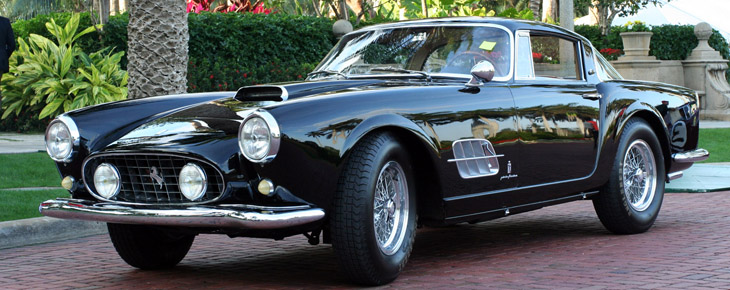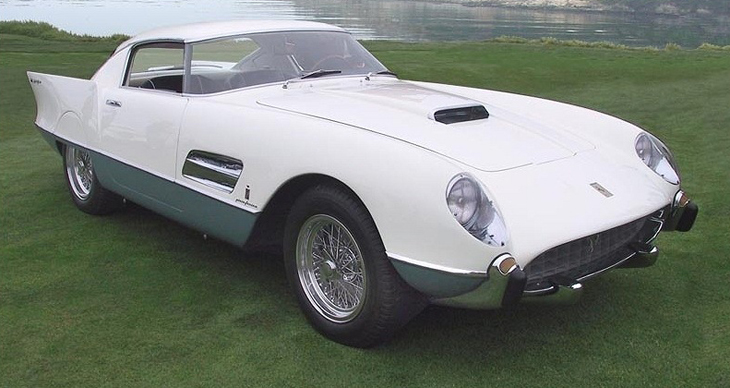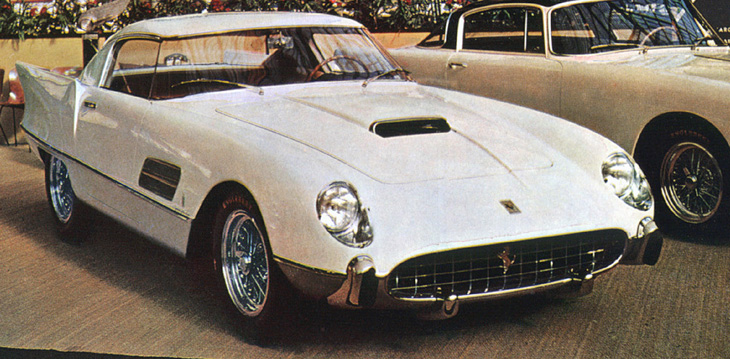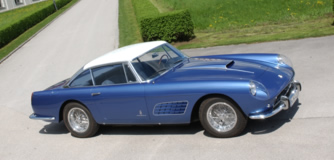|
Late in 1958 the Series III model was presented at the Paris Salon, this series also being on a 2600mm wheelbase, with a new derivation of the body style by Pinin Farina.
Visually the shape of the car
shown at the Brussels Salon in 1956 was very similar to the new design for the 250 GT coupe by Pinin Farina, which would evolve into the 250 GT Boano and Ellena series. This body style clothed the majority of the Series I and
II cars produced, but there were a few examples that sported radically different one-off coachwork. As the 410 Superamerica models were very expensive and exclusive automobiles for very wealthy clients, there were detail
differences even on the "standard" coupes to suit a client's specific wishes.
The one-off coachwork offerings for these Series I and II cars were amongst the most bizarre ever to grace a Ferrari chassis. Pinin
Farina produced two entirely different "Superfast" studies. The first was shown at the 1956 Paris Salon, on chassis # 0483SA, featuring a cantilevered roof with no front screen pillars (later added before sale), with
emphatic tail fins incorporating triangulated rear light assemblies in the trailing edge. It was finished in a white over pale metallic blue colour scheme, split by a chrome trim that circumnavigated the car from either side of
the wide oval radiator grille. The second "Superfast", built on chassis # 0719SA, was presented at the 1957 Turin Salon, and whilst similar around the nose and cabin areas, had a more elegant and restrained tail
treatment, that sat more harmoniously with the curves of the front of the car. The then major builder of Ferrari competition car bodies, Scaglietti, also bodied one example on chassis # 0671SA, which again featured tail fins,
showing the transatlantic influence on cars mainly aimed at the American market, whilst the use of bare stainless steel for the roof, sill and fin panels, provided a strong contrast to the dark red bodywork. Carrozzeria Boano
gave their interpretation on the fin theme, with a coupe built on chassis # 0477SA, that featured a split rear window, and on a similarly bodied cabriolet built on chassis # 0485SA, both featuring curved tail fins. However, it
was Ghia who took the prize for the biggest and longest tail fins, with their offering on chassis # 0473SA, inspired by their previous dream cars "Gilda" and "Dart" which were built for Chrysler.
The
chassis' for the Series I and II cars, with factory type reference 514, whether 2600mm or 2800mm wheelbase, were numbered in the odd number road car sequence carrying an "SA" suffix, and were similar in concept to the
concurrent 250 GT units, whereby the main chassis tubes passed above the rear axle, as opposed to under the axle on the 375 America. The front and rear track was also increased over that of the 375 America. The suspension was
independent at the front, via wishbones with individual coil springs and shock absorbers, whilst the rigid rear axle was supported on semi elliptic leaf springs, and fitted with hydraulic shock absorbers. Hydraulically operated
drum brakes were fitted all round, with a cable operated handbrake to the rear wheels.
The Series I and II engines, with factory type reference 126, were a further development of the Lampredi "long" block unit
used in the 375 America, increased in capacity to 4962cc, by enlarging the bore from 84mm to 88mm diameter, whilst retaining the same 68mm stroke. Triple twin choke Weber 40 DCF carburettors were fitted, with a twin coil and
distributor ignition system, to provide a claimed power output of 340bhp. This was coupled to a four speed all synchromesh gearbox, driving through a propeller shaft to the rigid rear axle, for which a range of ratios were
available. The engine of the first Pinin Farina "Superfast" derivative was fitted with a twin spark plug per cylinder arrangement, developed directly from the Formula 1 and sports racing cars, and had larger 42mm twin
choke carburettors.
The chassis' for the Series III cars, with factory type reference 514/A, with a 2600mm wheelbase, were also numbered in the odd number road car sequence carrying an "SA" suffix, and the
mechanical components of the chassis were as those of the preceding series. The Pinin Farina designed body style was common to all cars in the series, apart from the original show car prototype, that had a five window glass
arrangement, all subsequent examples being fitted with a three window arrangement. However, individual differences continued to exist, the most noticeable being with the headlights, some cars having open lights, and others with
them recessed in the front wings under Perspex covers.
The Series III engine, with factory type reference 126/58, was fitted with redesigned cylinder heads that had the sparking plugs on the outside of the vee, hitherto
all Ferrari V12 production car engines had the sparking plugs within the vee. This feature would also later appear on the 3 litre 250 GT series engine. This was the final development of the Lampredi "long" block engine with the
screw in cylinder liners to the head, hereafter the more conventional arrangement of using slip fit liners with a head gasket would be used on engines of all capacities. An unusual feature of the engine was that the connecting
rods were machined from a solid billet of steel, a feature normally reserved for some Ferrari competition engines, rather than being fitted with normal forged steel rods. Triple twin choke Weber 46 DCF3 carburettors were
fitted, with a twin coil and distributor ignition system, to provide a claimed power output of 360bhp. This was coupled to a four speed all synchromesh gearbox, with a different shift pattern to the earlier Superamerica models,
with the same drive train layout and optional axle ratios as the earlier models in the series.
Engine
- Type front, longitudinal 60° V12
- Bore/stroke 88 x 68 mm
- Unitary displacement 413.46 cc
- Total displacement 4962.96 cc
- Compression ratio 8.5 : 1
- Maximum power 250 kW (340 hp) at 6000 rpm
- Power per litre 69 hp/l
- Valve actuation single overhead camshaft per bank, two valves per cylinder
- Fuel feed three twin-choke Weber 46 DCF/3 carburettors
- Ignition single spark plug per cylinder, two coils
- Lubrication wet sump
- Clutch multi-plate (three clutch plates)
Chassis
- Frame tubular steel
- Front suspension independent, unequal-length wishbones, coil springs, telescopic shock absorbers
- Rear suspension live axle, semi-elliptic springs, large telescopic shock absorbers
- Brakes drums
- Transmission 4-speed + reverse
- Steering worm and sector
- Fuel tank capacity 100 litres
- Front tyres 6.50 x 16
- Rear tyres 6.50 x 16
Bodywork
- Type coupé, cabriolet, two-seater
- Wheelbase 2800 mm
- Front track 1455 mm
- Rear track 1450 mm
- Weight 1200 kg (dry)
Performance



|



